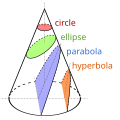Hypatia
Hypatia (hy-PAY-shee-uh) of Alexandria was a mathematician, astronomer, and philosopher. She lived around 370 - 415 CE and was the first noted women in mathematics, philosophy, and astronomy. She led a philosophical movement called Neoplatonism, which was developed from the ideas of the ancient Greek philosopher Plato.
Hypatia was born in Alexandria, a city in Egypt. During Hypatia’s time, Egypt was a great place for learning. Her father was also a mathematician, astronomer, and philosopher and so she had it in her bloodline. Her father was Theon. Hypatia and her father worked on commentaries of Ptolemy's work together. Ptolemy was a Greek astronomer who was from Alexandria. Hypatia's name was also put on work done by other mathematicians.
The Museum of Alexandria was a more like a university and library than a museum. It played a big role in education, and Hypatia’s life. Theon may have been the director of the museum at one point. Theon was interested in mathematics, which may have led Hypatia to pursue astronomy, mathematics, and philosophy.
Her skills were so notable that she became the leader of the Neoplatonism movement in Alexandria around 400. Her reputation led students from all around the world to come visit here. She was recognized as a better philosopher than most of the men during her time. Hypatia gave lectures at her house and in lecture halls. She lectured on astronomy, mathematics, philosophy, and religious literature. She wrote a number of books about mathematics.[1][2]
Synesius of Cyrene was a student of Hypatia. His letters provided some of the most important information on her life and her teachings. She taught Synesius about the building of an astrolabe.
Hypatia never married because she said she was “wedded to the truth”. She was an acquaintance of Orestes. He was the pagan governor of Alexandria. Radical monks, stirred up by the local bishop, murdered her. They possibly murdered her because the pagans seemed to have caused enmity among the mainly-Christian town even though she had Christian friends. They persecuted her and scattered her body parts around the city. She died at 45 years old, in 415 C.E.
References
- ↑ "Hypatia Of Alexandria". Gale Student Resources. Encyclopedia of World Biography. 1998. Retrieved March 31, 2017.
- ↑ Calinger, Ronald (2017). "Hypatia". World Book Student. Retrieved March 31, 2017.
Hypatia Media
Hypatia's father Theon of Alexandria is best known for having edited the existing text of Euclid's Elements, shown here in a ninth-century manuscript
Original Greek text of one of Synesius's seven extant letters to Hypatia from a 1553 printed edition
Drawing from the Alexandrian World Chronicle depicting Pope Theophilus of Alexandria, gospel in hand, standing triumphantly atop the Serapeum in 391 AD
Hypatia is known to have edited at least Book III of Ptolemy's Almagest, which supported the geocentric model of the universe shown in this diagram.
Hypatia wrote a commentary on Apollonius of Perga's treatise on conic sections, but this commentary is no longer extant.
Hypatia is known to have constructed plane astrolabes, such as the one shown above, which dates to the eleventh century.
Icon of Saint Catherine of Alexandria from Saint Catherine's Monastery in Sinai, Egypt. The legend of Saint Catherine is thought to have been at least partially inspired by Hypatia.
The eighteenth-century English Deist scholar John Toland used Hypatia's death as the basis for an anti-Catholic polemic, in which he changed the details of her murder and introduced new elements not found in any of his sources in order to portray Cyril in the worst possible light.
<ref> tag defined in <references> has group attribute "" which does not appear in prior text.<ref> tag defined in <references> has group attribute "" which does not appear in prior text.<ref> tag defined in <references> has group attribute "" which does not appear in prior text.<ref> tag defined in <references> has group attribute "" which does not appear in prior text.<ref> tag defined in <references> has group attribute "" which does not appear in prior text.<ref> tag defined in <references> has group attribute "" which does not appear in prior text.<ref> tag defined in <references> has group attribute "" which does not appear in prior text.<ref> tag defined in <references> has group attribute "" which does not appear in prior text.<ref> tag defined in <references> has group attribute "" which does not appear in prior text.<ref> tag defined in <references> has group attribute "" which does not appear in prior text.<ref> tag defined in <references> has group attribute "" which does not appear in prior text.<ref> tag defined in <references> has group attribute "" which does not appear in prior text.<ref> tag defined in <references> has group attribute "" which does not appear in prior text.<ref> tag defined in <references> has group attribute "" which does not appear in prior text.<ref> tag defined in <references> has group attribute "" which does not appear in prior text.<ref> tag defined in <references> has group attribute "" which does not appear in prior text.<ref> tag defined in <references> has group attribute "" which does not appear in prior text.<ref> tag defined in <references> has group attribute "" which does not appear in prior text.<ref> tag defined in <references> has group attribute "" which does not appear in prior text.






